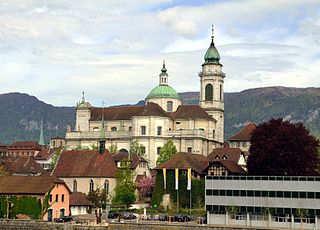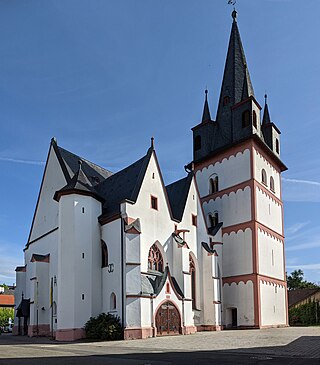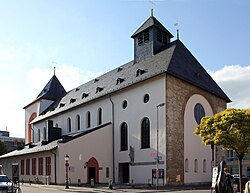
Cologne Cathedral is a cathedral in Cologne, North Rhine-Westphalia belonging to the Catholic Church. It is the seat of the Archbishop of Cologne and of the administration of the Archdiocese of Cologne. It is a renowned monument of German Catholicism and Gothic architecture and was declared a World Heritage Site in 1996. It is Germany's most visited landmark, attracting an average of 6 million people a year. At 157 m (515 ft), the cathedral is the tallest twin-spired church in the world, the second tallest church in Europe after Ulm Minster, and the third tallest church of any kind in the world.

Mainz Cathedral or St. Martin's Cathedral is located near the historical center and pedestrianized market square of the city of Mainz, Germany. This 1000-year-old Roman Catholic cathedral is the site of the episcopal see of the Bishop of Mainz.

The Church of John the Baptist is the oldest Lutheran church in Lüneburg, Germany. It is located in the city centre. Lüneburg is on the European Route of Brick Gothic and the church is an example of this style. With its 108-meter high spire, it is the second tallest church tower in Lower Saxony – after St. Andrew's in Hildesheim.

The St. Thomas Church is a Lutheran church in Leipzig, Germany, located at the western part of the inner city ring road in Leipzig's central district. Martin Luther preached in the church in 1539. It is associated with several well-known composers, especially Johann Sebastian Bach, who was its Thomaskantor from 1723 until his death in 1750. The church holds his remains.

St Peter's Cathedral is a Roman Catholic church and former cathedral in Worms, southern Germany.

The Carolingian Saint Justin's Church in Frankfurt-Höchst is the oldest building in Frankfurt/Main and one of the oldest churches still existing in Germany. It is dedicated to Saint Justin the Confessor.

The Great Saint Martin Church is a Romanesque Catholic church in Cologne, Germany. Its foundations rest on remnants of a Roman chapel, built on what was then an island in the Rhine. The church was later transformed into a Benedictine monastery. The current buildings, including a soaring crossing tower that is a landmark of Cologne's Old Town, were erected between 1150-1250. The architecture of its eastern end forms a triconch or trefoil plan, consisting of three apses around the crossing, similar to that at St. Maria im Kapitol. The church was badly damaged in World War II; restoration work was completed in 1985.

Limburg Cathedral (German: Limburger Dom, also known as Georgsdom after its dedication to Saint George, is located above the old town of Limburg in Hesse, Germany. It is the cathedral of the Catholic Diocese of Limburg. Its high location on a rock above the river Lahn provides its visibility from far away. It is the result of an Early Gothic modernization of an originally Early Romanesque building and therefore shows a Romanesque-Gothic transitional style.

Erkanbald was the Abbot of Fulda from 997 and afterwards Archbishop of Mainz from 1011 until his death.

Maria Regina Martyrum is a Roman Catholic church of the Roman Catholic Archdiocese of Berlin in Berlin, borough Charlottenburg-Wilmersdorf, in the locality of Charlottenburg-Nord. The church was built on behalf of the German Catholics to honour the Martyrs of Freedom of Belief and Conscience from the years 1933–1945. It is located 20 min of walk from the place of execution of Nazi resistants and opponents within the Plötzensee Prison, now the memorial Gedenkstätte Plötzensee.

Fulda Cathedral is the former abbey church of Fulda Abbey and the burial place of Saint Boniface. Since 1752 it has also been the cathedral of the Diocese of Fulda, of which the Prince-Abbots of Fulda were created bishops. The abbey was dissolved in 1802 but the diocese and its cathedral have continued. The dedication is to Christ the Saviour. The cathedral constitutes the high point of the Baroque district of Fulda, and is a symbol of the town.

The Basilica of St. Castor is the oldest church in Koblenz in the German state of Rhineland Palatinate. It is located near Deutsches Eck at the confluence of the Rhine and the Moselle. A fountain called Kastorbrunnen was built in front of the basilica during Napoleon's invasion of Russia in 1812. Pope John Paul II raised St. Castor to a basilica minor on 30 July 1991. This church is worth seeing for the historical events that have occurred in it, its extensive Romanesque construction and its largely traditional furnishings.

The St. Ursus Cathedral or Solothurn Cathedral is the cathedral of the Roman Catholic Diocese of Basel in the city of Solothurn, Switzerland. It is a Swiss heritage site of national significance.

St Martin's Church is a Protestant parish church in Kassel, Hesse, Germany. It is also the preaching-church of the bishop of the Evangelical Church of Hesse Electorate-Waldeck. It is in the Gothic style and was begun in 1364 and completed in 1462, dedicated to St. Martin of Tours. It became a Protestant church in 1524, when Philip I, Landgrave of Hesse converted to Protestantism. From the 16th century until the end of the 18th century it was the burial place for the landgraves of Hesse.

The Catholic church of St. Quintin is the parish church of the oldest proven parish in the city of Mainz. Today, St. Quintin together with the cathedral community of St. Martin forms the parish of St. Martin's Cathedral and St. Quintin. Thus the cathedral priest is therefore always the priest of St. Quintin as well.

St. Martin is a Gothic church and the associated Catholic parish in Lorch am Rhein, Hesse, Germany. In 2002, it became part of the Rhine Gorge, a UNESCO World Heritage Site. The church features the oldest and largest monochrome wood-carved altar in Germany. Its organ from 1984 makes it also a concert venue, where international organists such as Olivier Latry have performed.

St. Johannis or Johanniskirche is a Lutheran church and parish, dedicated to John the Baptist, in Schalkau, Thuringia, Germany. The listed monument is a landmark of the town.

Mainz Charterhouse is a former Carthusian monastery, or charterhouse, in Mainz, Rheinland-Pfalz, Germany, demolished in 1790–1792 but still marked by the street-name "Karthaus".

St. Martin is the name of a Catholic church and former parish in Oestrich, Rheingau-Taunus-Kreis, Germany. It was built as a hall church from 1508 in late-Gothic style. It was destroyed in the Thirty Years' War and rebuilt in simpler style, but restored to its Gothic appearance in 1894.

St. Peter und Paul, Eltville is the name of a Catholic church and parish in Eltville, Rheingau-Taunus-Kreis, Germany, dedicated to Saints Peter and Paul. The parish is part of the Diocese of Limburg. Several parishes were merged into St. Peter und Paul in 2015.





















